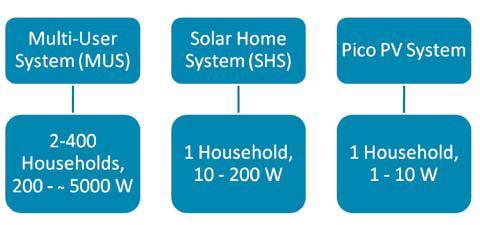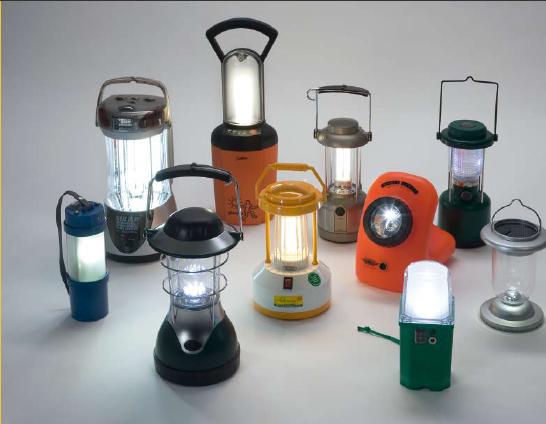Difference between revisions of "Features of PicoPV Systems"
***** (***** | *****) m |
***** (***** | *****) m |
||
| Line 75: | Line 75: | ||
<references /> | <references /> | ||
| + | [[Category:PicoPV]] | ||
[[Category:Solar]] | [[Category:Solar]] | ||
| − | |||
| − | |||
Revision as of 13:11, 26 February 2013
Overview - Definition
PV off-grid systems are mainly defined through power dimension and the number of users[1].
All systems include one or more solar modules of different sizes and various appliances. Frequently used categories are multiuser systems (MUSs), solar home systems (SHSs) and the very small PicoPV systems.
PicoPV systems are small independent appliances providing light and/or additional small electrical services, such as radios, mobile phone charging, mp3 player, etc. These systems allows the substitution of traditional light sources like inefficient and relatively dark kerosene lamps.
PicoPV System Components
A PicoPV system mainly consists of three components:
The PV panels for the lights are mostly made of polycrystalline- or mono-crystalline silicon. The nameplate power ranges from 0.3 Wp for a solar lantern with an integrated panel up to 12 Wp for the combined system. The majority of the systems are equipped with panels from 1 to 3 Wp.
There are different types of batteries used in the systems,lead-acid (33%) and NiMH (60%) batteries being the most common types, while Li-Ion (7%) batteries are presently used only in few cases. [3] The trend of using PicoPV systems with NiMH and Lithium ion increase. They replace lower quality batteries, such as the lead-acid battery. Comparing options of better quality batteries, NiMH show memory effects and lower power than Litium ion.[3] A charge controller is important to protect the battery from damage through overcharging or deep-discharging. [4]
A PicoPV system can be equipped with various lighting technologies. Compact fluorescent lamps (CFL) are based on the same functional principle as standard fluorescent lamps, but are more energy efficient than the latter as they work at a higher internal pressure, are smaller and have a higher illuminating power. At present the light emitting diode (LED) technology seems to be the most forward-looking option. Although this light source still lacks behind the light output of energy-efficient CFL, LED lamps consume less energy, while their quality standards are improving at a fast pace. Both CFL and LED bulbs outperform by far the traditional lighting technologies based on kerosene, biomass, diesel, propane and wax (used by 14% of urban households and 49% of rural households in the developing world IEA 2002 cited in Mills 2005), in terms of output of lumen per watt.
An increasing number of mature PicoPV systems provide additional energy services through various appliances which can be integrated in a multipurpose system or connected as external devices through a plug:
- ICT Appliances
The presently most common and popular appliance is a mobile phone charger which is either connected to the main device (the lamp) through a cable for charging from the battery, or directly to the module. These systems usually come with a set of different phone charging pins intended to cover a range of the most widely spread mobile phone types.
Many models of PicoPV systems also allow for the operation of other small electric devices such as a small radio, small loudspeakers, or a MP3-player. In general, the size of the module and the storage capacity of the battery determine the range of electric appliances which can be connected to the system. If required even a small TV or a little fridge can be operated. One example is the seven inch solar LCD Colour TV of Free Energy Europe which consumes less than 10 W per hour. In addition, various standard plugs USB-ports are also on the rise. They facilitate the operation of a huge range of small USB-devices like for example small fans.
Product Types
New products are introduced to the market nearly daily. Even there is no common typology of lamps yet, a few insititutions refer to a typology of products in order to differentiate between the big range of PicoPV products.
Quality of PicoPV Systems
Meanwhile a huge amount of different solar lamps is introduced to the market. Number of new models increases almost daily. Therefore, it is difficult to find an adequate solar lamp regarding type and quality. In order to prevent customers from products of bad quality and destroy local markets, several laboratory tests were accomplished to evaluate products. To complement this data, field tests in various countries took place in order to test the products under real-life conditions.
Lighting africa developed a comprehensive quality test method (QTM) and established a minimum performace requrments for the Pico PV sytems. Here you can find a list of the products that met the minimum quality standards.
References
- ↑ Mitja et al., 2003
- ↑ 2.0 2.1 _ Cite error: Invalid
<ref>tag; name "Difference" defined multiple times with different content - ↑ 3.0 3.1 Lighting Africa. 2010. Solar Lighting for the Base of the Pyramid - Overview of an Emerging Market - Cite error: Invalid
<ref>tag; name "BOP" defined multiple times with different content - ↑ Solar Energy Foundation. 2010. Sun connect. Check list solar lamps
- ↑ GTZ. 2009. Solar Laterns Test: Shades of Light.





















